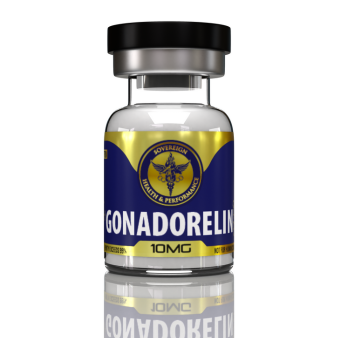Gonadorelin vs. Enclomiphene
Both Gonadorelin and Enclomiphene are used to stimulate testosterone production, but they work through different mechanisms and have distinct profiles. Below is a detailed comparison and contrast of the two.
Of particular note are the side effects and different methods of administration (injection vs oral). This likely is a factor in doctors recommending Enclomiphene despite its greater potential negative side effects compared to Gonadorelin.
Table of Contents
Gonadorelin

Mechanism of Action:
- GnRH Analog: Gonadorelin is a synthetic form of gonadotropin-releasing hormone (GnRH).
- Pituitary Stimulation: It stimulates the pituitary gland to release luteinizing hormone (LH) and follicle-stimulating hormone (FSH).
- Testosterone Production: LH stimulates the Leydig cells in the testes to produce testosterone.
Usage:
- Often used to maintain testicular function and fertility during testosterone replacement therapy (TRT).
- Can be used to diagnose pituitary gland function.
Administration:
- Route: Subcutaneous or intramuscular injection.
- Frequency: Typically administered 2-3 times per week.
Benefits:
- Directly increases LH and FSH levels.
- Helps maintain testicular size and spermatogenesis.
Side Effects:
- Headache
- Nausea
- Injection site reactions (pain, redness, swelling)
- Rarely, allergic reactions
Enclomiphene
Mechanism of Action:
- Selective Estrogen Receptor Modulator (SERM): Enclomiphene is the trans-isomer of clomiphene citrate, a SERM.
- Estrogen Receptor Blockade: It blocks estrogen receptors in the hypothalamus.
- Increased GnRH Secretion: This leads to increased secretion of GnRH, which in turn increases LH and FSH release from the pituitary.
- Testosterone Production: Increased LH stimulates the Leydig cells to produce testosterone.
Usage:
- Used as an alternative to TRT to stimulate natural testosterone production.
- Often prescribed to men with secondary hypogonadism.
Administration:
- Route: Oral
- Frequency: Typically administered daily.
Benefits:
- Non-injection method (oral administration).
- Increases endogenous testosterone production.
- Maintains spermatogenesis and fertility.
- Generally well-tolerated.
Side Effects:
- Hot flashes
- Visual disturbances
- Mood swings
- Nausea
- Headache
Comparison and Contrast
Mechanism:
- Gonadorelin: Directly stimulates the pituitary to release LH and FSH.
- Enclomiphene: Increases GnRH secretion indirectly by blocking estrogen receptors in the hypothalamus.
Administration:
- Gonadorelin: Injectable (subcutaneous or intramuscular).
- Enclomiphene: Oral.
Frequency:
- Gonadorelin: Administered 2-3 times per week.
- Enclomiphene: Typically taken daily.
Side Effects:
- Both can cause headaches and nausea, but Enclomiphene has additional potential side effects like hot flashes and visual disturbances.
Use Cases:
- Gonadorelin: Often used in conjunction with TRT or for diagnostic purposes.
- Enclomiphene: Used as an alternative to TRT, especially for men with secondary hypogonadism, and to maintain fertility.
Effectiveness:
- Both are effective at increasing testosterone levels and maintaining spermatogenesis, but the choice between them may depend on patient preference for administration method, tolerance of side effects, and specific clinical scenarios.
Conclusion
In summary, both Gonadorelin and Enclomiphene are valuable for increasing testosterone production and maintaining fertility, but they have different mechanisms of action, routes of administration, and side effect profiles. The choice between them should be guided by individual patient needs and medical advice.

